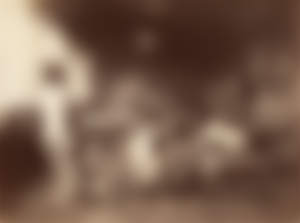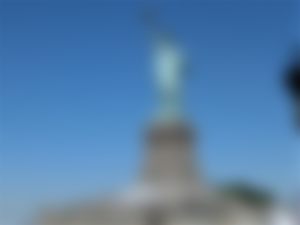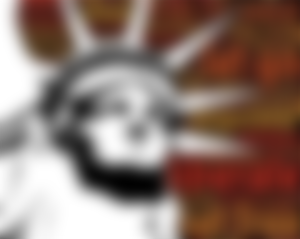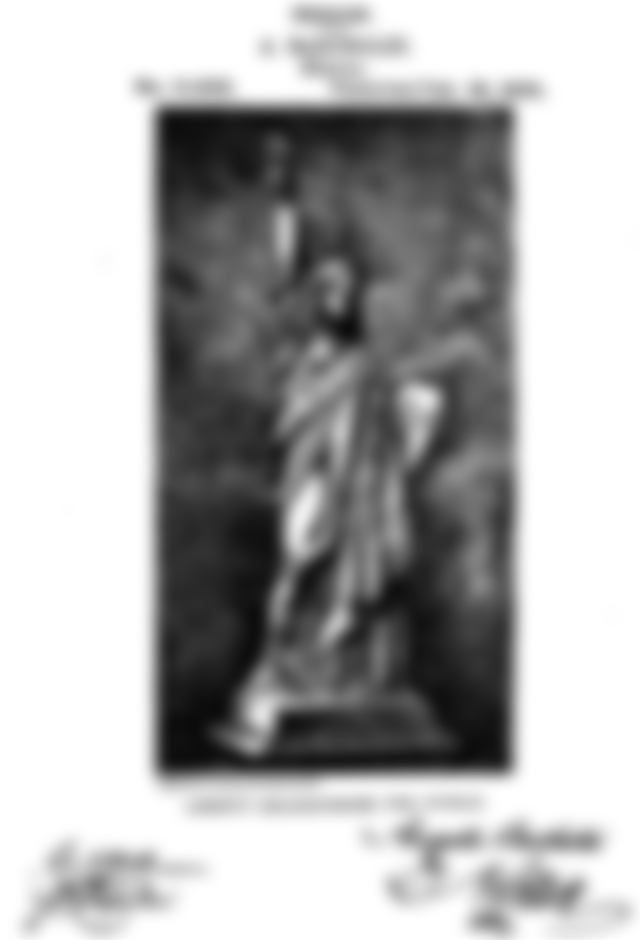In the memory of desperate people from all over Europe (Poles, Russians, Irish, Greeks and Italians) who at the end of the 19th and half of the 20th century emigrated to North America to escape hunger and misery from political and racial persecution or just for the spirit of adventure, the immense and severe size of the Statue of Delta Freedom, which stands at the Port of New York, with that arm outstretched towards the sky to hold the jib, has remained forever the first image of their new homeland: America. Almost all the members of this tragic European diaspora died without knowing or worrying about where it had come from, who had conceived and built it like this: with that austere woman's face, the seven-pointed crown, the book of the law and the torch (Masonic symbols?) and how long it had been at the entrance to the port of New York to welcome the ships of thousands of desperate aspirants in search of the new Eldorado. Probably most of them believed that the statue was born with the United States, it was an American product destined to give hope to the desperate, to promise bread to the hungry and justice and freedom to the persecuted, after all, they did not care about its history, but only about what it represented for them at that moment: the hope of a better existence. In truth, how many Americans today know his story more than a century later, which began in Paris with a family lawsuit that had Napoleon III as its main actors, Professor Edouard Laboulaye, a Republican and liberal, a young Alsatian sculptor named Auguste Bartholdi and an engineer, Gustave Eiffel, who later built the tower that would make him famous. So the statue was an all Parisian story, which only later became the incarnation of the American dream. The statue was the bone of contention between the emperor and his republican and liberal adversaries, between the first who in the war of secession agreed for the slave South and the second for the North if only to irritate him without compromising himself in open internal political positions (always dangerous at the time of the Second Empire).

The story goes that this was the case: Edouard Laboulaye and his friends from the "society against slavery" had decided to offer the United States a statue symbolising freedom for 1876, the first centenary of their independence, and Bartholdi, who had already tried unsuccessfully to place a gigantic statue at the entrance to the Suez Canal, which had not yet been inaugurated, offered to make it, being a maniac of gigantism. As for Napoleon III, once faced with a fait accompli he could not have done much to prevent the donation: in the worst case, he would have had a bile attack, in the best case he would have blessed it and inaugurated it by plugging his nose. Months of slowdowns followed, even bureaucratic ones, in the realization of the statue, but the story always ends up settling things. Two years later France was defeated at Sedan and under the internal revolutionary uprisings the Second Empire collapsed and from its ashes, the Third Republic was about to be born with a new constitution. Bartholdi without work and without money, went to refresh his memory in Laboulaye: "we finish the Statue now that Napoleon is no more and the centenary of the Independence of the United States is near". Having said that, Bartholdi is summoned to the United States to decide the location of the statue and when he returns home he communicates the place: the bay of New York. But the coffers of the new French Republic are empty and the statue, according to an estimate, without a pedestal, will cost the new government 600,000 francs, a fortune. In 1876 (the year of American Independence) Bartholdi had only completed the immense arm holding the torch and showed it to his American friends, the latter were sceptical and more than once in their national newspapers laughed at the work, convinced that it would never be completed. In 1878, with his arm still around America, Bartholdi presented the enormous head at the Universal Exhibition in Paris at the Champ de Mars where, twenty years later, Eiffel would build his tower. It was on that very occasion, while the Parisians were amazed to learn about the enormous crowned head that Gustave Eiffel came into play. At the end of the day and knowing the overall weight of the Statue of Liberty in copper plate, it was necessary to design and build a solid internal structure on which to model the immense body, the structure had to be weatherproof in Hudson Bay and resist the powerful gusts of wind. And Eiffel threw himself head down into the project, building the huge frame of iron beams and cross stairs that were the skeleton of the statue, convinced that his engineering work could last at least a hundred years without extraordinary maintenance. Eiffel came up with the idea for his iron tower during the construction of the Statue of Liberty.

Finally Bartholdi, thanks to a fundraiser (and the help of Freemasonry?) both at home and in America, managed to finish the body of his statue. In 1884 the inhabitants of Paris saw the "new colossus of Rhodes", a statue almost fifty metres high, rise high on the rooftops of their city. All's well that ends well, if as well as the Americans, no longer believing in the project, had interrupted the construction of the pedestal. But the statue was there ready to take to the sea, disassembled and packed in 220 numbered boxes, destined to dominate the bay of Ney York. In record time the Americans put their hands back on their wallets and completed the base. Twenty years after Edouard Laboulaye's idea, the statue was finally inaugurated and presented to an incredulous and excited Bartholdi. From that 28th October 1886 Lady Liberty: a statue 46 metres high (93 metres including the base) dressed in a long toga and holding a torch on the right (symbol of freedom) and on the left the book engraved with the date of American independence (4th July 1776), with a crowned seven-pointed head (representing the seven seas and seven continents) with broken chains at the feet symbolising any liberation from tyranny, dominates the bay of Ney York.
ITA
Nella memoria di disperati di tutta Europa (polacchi, russi, irlandesi, greci e italiani) che alla fine del 800’ e per metà del 900’ che emigrarono nell’America del Nord per sfuggire alla fame e alla miseria alle persecuzioni politiche e razziali o soltanto per spirito d’avventura la mole immensa e severa della Statua delta libertà, che si erge all'Imbocco del porto dì New York, con quel braccio teso verso il cielo a reggere la fioccala, è rimasta per sempre la prima immagine della nuova loro patria: l’America. Quasi tutti i membri di questa tragica diaspora europea sono morti senza sapere o senza preoccuparsi di sapere da dove fosse venuta, chi l’avesse ideata e costruita così: con quel volto austero di donna, la corona a sette punte, il libro della legge e la fiaccola (simboli massonici?) e da quanto tempo si trovasse all’entrata del porto di New York ad accogliere le nave di migliaia di disperati aspiranti in cerca del nuovo Eldorado. Probabilmente la maggior parte di essi credeva che la statua fosse nata con gli Stati Uniti, era un prodotto americano destinato a dare speranza ai disperati, a promettere pane agli affamati e giustizia e libertà ai perseguitati, del resto a loro non importava la sua storia, ma solo quello che per loro in quel momento rappresentava: la speranza di un’esistenza migliore. In verità quanti al giorno d’oggi sia americani conoscono a più di un secolo di distanza la sua storia, cominciata a Parigi con una querelle di famiglia che ha come attori principali Napoleone III, il professor Edouard Laboulaye, repubblicano e liberale, un giovane scultore alsaziano di nome Auguste Bartholdi e un ingegnere, certo Gustave Eiffel che più tardi costruirà la torre che lo renderà famoso. Quindi la statua era una storia tutta parigina, diventata solo in seguito l’incarnazione del sogno americano. La statua era il pomo della discordia tra l’imperatore e i suoi avversari repubblicani e liberali, tra il primo che nella guerra di secessione patteggiava per il Sud schiavista e i secondi per il Nord se non altro per irritarlo senza compromettersi in aperte posizioni politiche interne (sempre pericolose ai tempi del Secondo Impero). Si narra che era andata così: Edouard Laboulaye e i suoi amici della “società contro lo schiavismo” avevano deciso di offrire agli Stati Uniti per il 1876, primo centenario della loro indipendenza, una statua che simboleggiasse la libertà e Bartholdi, che aveva già tentato senza successo di piazzare una gigantesca statua all’ingresso del canale di Suez non ancora inaugurato, si era offerto di realizzarla essendo un maniaco del gigantismo. Quanto a Napoleone III una volta messo di fronte al fatto compiuto non avrebbe potuto fare un granché per impedirne la donazione: nel peggiore dei casi avrebbe avuto un attacco di bile, nei migliori l’avrebbe benedetta e inaugurata tappandosi il naso. Seguirono mesi di rallentamenti, anche burocratici, nella realizzazione della statua, ma la storia finisce sempre per sistemare le cose. Due anni dopo la Francia viene sconfitta a Sedan e sotto i moti rivoluzionari interni il Secondo Impero crollò e dalle sue ceneri stava per nascere la Terza Repubblica con una nuova costituzione. Bartholdi senza lavoro e senza soldi, andò a rinfrescare la memoria a Laboulaye: “finiamo la Statua ora che Napoleone non c’è più e il centenario dell’Indipendenza degli Stati Uniti è vicino”. Detto fatto, Bartholdi è convocato negli Stati Uniti per decidere la collocazione della statua e quando torna in patria comunica il luogo: la baia di New York. Ma le casse della nuova Repubblica francese sono vuote e la statua secondo un preventivo, priva del piedistallo, costerà al nuovo governo 600.000 franchi, una fortuna. Nel 1876 (anno dell’Indipendenza americana) Bartholdi aveva completato solamente l’immenso braccio che reggeva la fiaccola e lo mostrò agli amici americani, quei ‘ultimi si rivelarono scettici e più di una volta sui loro quotidiani nazionali derisero l’opera convinti che non sarebbe mai stata completata. Nel 1878, con il braccio ancora in giro per l’America, Bartholdi presentò l’enorme testa all’ Esposizione Universale di Parigi a Campo di Marte dove un ventennio più tardi Eiffel costruirà la sua torre. È proprio in quell’occasione, mentre i parigini fanno stupiti la conoscenza dell’enorme testone coronato che entra in gioco Gustave Eiffel. A conti fatti e conosciuto il peso complessivo della Statua della Libertà in lamiere di rame, occorreva progettare e costruire una solida struttura interna sulla quale modellare l’immenso corpo, la struttura doveva essere resistenze alle intemperie della baia di Hudson e resistere alle potenti raffiche di vento. Ed Eiffel si lanciò a testa bassa nel progetto, costruendo l’enorme intelaiatura di travi di ferro e scale incrociate che erano lo scheletro della statua, convinto che la sua opera di ingegneria potesse durare almeno cent’anni senza manutenzioni straordinarie. Eiffel maturò l’idea della sua torre di ferro proprio durante la costruzione della Statua della Libertà.

Finalmente Bartholdi, grazie a una raccolta fondi (e all’aiuto della massoneria?) sia in patria che in America riuscì a finire il corpo della sua statua. Nel 1884 gli abitanti di Parigi videro sorgere alta sui tetti della loro città il “nuovo colosso di Rodi”, una statua alta quasi cinquanta metri. Tutto bene quello che finisce bene, se nonché gli americani, non credendo più nel progetto, avevano interrotto la costruzione del piedistallo. Ma la statua era lì pronta per prendere il mare, smontata e imballata in 220 casse numerate, destinata a dominare la baia di Ney York. A tempo di record gli americani rimisero mani al portafoglio e completarono la base. Dopo vent’anni dal’ idea di Edouard Laboulaye la statua venne finalmente inaugurata e presentata la mondo al cospetto di un incredulo ed emozionato Bartholdi. Da quel 28 ottobre 1886 Lady Liberty: una statua alta 46 metri (93 compreso il basamento) vestita di una lunga toga e che regge nella destra una fiaccola (simbolo della libertà) e nella sinistra il libro con incisa la data dell’indipendenza americana (4 luglio 1776), con un testa coronata a sette punte ( in rappresentanza dei sette mari e dei sette continenti) con le catene spezzate ai piedi simbolo di qualsiasi liberazione dalla tirannia, domina la baia di Ney York.





Awesome